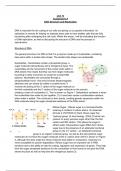Unit 13
Assignment A
DNA Structure and Replication
DNA is important for the coding of our cells and giving us our genetic information. Its
replication is moreso for helping us replicate these cells to have healthy cells that are fully
functioning after undergoing the cell cycle. Within this essay, I will be evaluating the function
of DNA replication, as well as discussing the structure of DNA and the process of
reproduction.
Structure of DNA
The general structure of a DNA is that it is a polymer made up of nucleotides, containing
base pairs within a double helix shape. The double helix shape runs antiparallel.
Nucleotides - Nucleotides contain a phosphate group, a
sugar molecule (deoxyribose) and a nitrogenous base. The
nucleotides are the monomers of the nucleic acids within a
DNA strand; this means that they can form larger molecules
by joining to other monomers to create the overall DNA
polymer. Nucleotides are connected through a
phosphodiester bond - this bond involves electromagnetic
attraction and can simply be called a covalent bond. It
involves the joining of the 3’ carbon of the sugar molecule on Figure 1 -
the first nucleotide and the 5’ carbon of the sugar molecule on the second,
creating a chain of nucleotides (1). This is shown on Figure 1. Dehydration synthesis is when
the nucleotides lose water to join together, (1) it could also cause a condensation reaction,
when water is added. This continues to form bonds, creating genetic sequences within the
DNA molecule along the sugar phosphate backbone of the DNA strand.
Ribose Sugar - Ribose sugar is a monosaccharide,
meaning it contains 5 carbon atoms. Its molecular
formula is C5H10O5 (2). Each ribose sugar has
‘hydroxyl group’ (A level biology, 2020) (2) which are
present on every pentose sugar other than the first
carbon and fifth carbon. This allows the sugar to
attract water. Deoxyribose sugar differs from ribose
sugar due to the presence of an aldehyde functional
group on the C1’ carbon - an aldehyde functional
Figure 2 - group is an organic molecule group. As well as this deoxyribose sugar
molecules do not have the oxygen molecule at the 2’ carbon atom which is shown on Figure
2, although this does make the ribose molecule less stable in comparison, meaning it is
more susceptible to quicker degradation. Ribose sugar has an important role in RNA
functions due to the ability to help the coding, regulation and expression of genes. They help
form the sugar phosphate backbone for the nucleotides to form bonds to and give the DNA
strand structure as well as help bind the nitrogenous bases (3).
, Sugar phosphate backbone - This gives the DNA structure and is in the shape of a double
helix, within this there are the deoxyribose sugar and the phosphates. They have the ability
to not only provide shape and structure, but also link all nucleotides and base pairs together
to form the genetic sequencing (4). The sugar phosphate backbone is the joining of the
phosphate groups and sugars through the phosphodiester bonds within a chain. It is
incredibly important for providing structure. The sugar phosphate backbone has directionality
(5), this also links to the 3’ and 5’ carbon molecules joining together to create a repeating
pattern. Overall, the backbone is incredibly vital to our functioning due to its ability to provide
transmission of genetic materials, and providing stability.
Complementary base pairing - Complementary base pairs
from through hydrogen bonding of the nitrogenous bases.
There are 4 different nitrogenous bases: Adenine, Thymine,
Cytosine and Guanine in DNA, and Adenine, Uracil, Cytosine
and Guanine in RNA. There are subsections of these
nitrogenous bases to determine how they will pair, these are
the purine bases and pyrimidine bases (6). Purine bases are
structured as a double-ring. The first six-membered ring
contains 2 carbon and 2 nitrogen atoms, and the second ring is five-membered Figure 3-
and is fused and shares atoms with the first ring at a carbon. Adenine and
Guanine are purine bases. Pyrimidine bases are structured as a single ring, containing 4
carbon and 2 nitrogen atoms (6). Thymine and Cytosine are pyrimidine bases. Figure 3
demonstrates the joining of a 6 member ring and a 5 member ring, and the single 6
membered ring for pyrimidine. Due to Chargaff’s Rule, it is stated ‘a purine always pairs with
a pyrimidine’ (Walsh, 2019) (6) except for Adenine and Cytosine, due to equal
concentrations between each base pairing. Hydrogen bonding happens between the base
pairs due to the space between the sugar phosphate backbone, when hydrogen bonding
Adenine and Thymine produce 2 hydrogen bonds and Guanine and Cytosine produce 3.
This allows for the ladders of genetic sequencing
to be produced and the double-helix ladder
structure to be formed as well as provide further
stability.
Semi-Conservative DNA Replication
Semi-conservative DNA replication happens in
order for mitosis (cell division) to take place.
Mitosis is used to create genetically identical
daughter cells of the parent cell, which has an
identical number of chromosomes.
As the S-Phase of the cell cycle is happening
DNA replication occurs. The S-Phase is one of
the interphases before the mitotic phase (or the
splitting of the cell) occurs. The S-Phase is also when the DNA still maintains the Figure 4 -
semi-condensed chromatin configuration. The sister chromatids receive an Annotated
identical copy of the genetic material before the division of the cell and enzymes
allow for the DNA to be duplicated (7).




